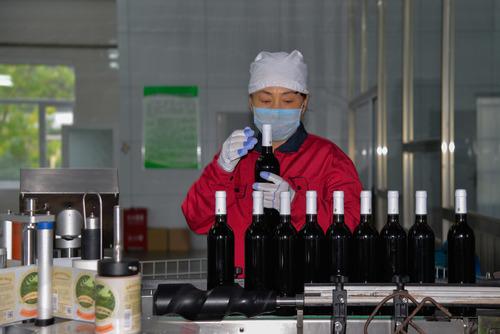YINCHUAN, Oct. 24 (Xinhua) -- An international wine expo that ended Friday once again put China's Ningxia Hui Autonomous Region under the spotlight.
The two-day event, namely the ninth Ningxia International Wine Expo at Helan Mountains' Eastern Foot, attracted hundreds of experts from 96 countries and regions to attend online and offline to share opinions on the development of the wine industry.
Ningxia has made great achievements with its product quality improved and brand polished under preferential policies for the wine industry, said Regina Vanderlinde, president of the Paris-based International Organization of Vine and Wine.
Over the years, Ningxia has been rapidly transforming itself into a major winemaking region in China. It currently has 32,800 hectares of grape plantation, generating an annual output of 130 million bottles of wine and a comprehensive output value of 26.1 billion yuan (about 3.9 billion U.S. dollars).
Ambition runs high as Ningxia plans to double the grape-growing area by 2025, with an annual production of 300 million bottles of wine.
VINEYARDS IN GOBI DESERT
With abundant sunshine, rich irrigation and an appropriate climate, Ningxia's vast barren Gobi Desert is deemed the "golden zone" for growing wine grapes.
Dating back to 1984, Yu Huiming, along with seven young winemakers, spent four months making wine in more than 100 pickle jars.
At that time, many Chinese wineries closed down due to a lack of industry standards, and few customers knew about wine. The winery Yu worked for, Ningxia's first, also underwent a rough time. "Workers couldn't get paid timely, and six of my colleagues left for a better living," Yu recalled.
However, Yu chose to stick to the industry.
In the 1990s, a foreign company bought the winery's overstocked wine and then sold the wine with the company's own label at 268 yuan per bottle.
"I realized that our wine has a market, but we needed our own brand to tap into the market," said Yu.
In 2011, Ningxia launched a basket of favorable policies to regulate the wine industry and encourage wineries to produce high-quality and branded wine.
Since then, the preferential policies have attracted a large number of chateaus from home and abroad to establish wineries in the region. As a result, batches of high-quality Ningxia wine flowed into the market.
So far, more than 1,000 varieties of wine from 50 local chateaus have won top wine contests around the world. Ningxia's wine has been exported to more than 20 countries and regions.
DREAMLAND FOR WINEMAKERS
Liao Zusong, 35, chief winemaker of the Xige Estate, a chateau in Ningxia, returned from an Australian wine farm in 2014. He participated in the whole winemaking process -- from the construction of Xige's vineyard and winery as well as the design of winemaking techniques.
"I want to be a winemaker who knows the whole production industry chain from grape growing to vinification," Liao said.
Xige now boasts of over 1,333 hectares of vineyards with an annual output of more than 1 million bottles. "I believe we can produce the best wine for customers across the country and even the world," said Liao.
Meanwhile, to polish local wine brands and improve winemaking skills, Ningxia has also invited winemakers from world-famous wine regions. So far, 60 winemakers from 23 countries and regions have come to Ningxia.
BOOMING WINE TOURISM
Zhao Liang, a tourist and also a wine lover from Beijing, drove all the way to Xige Estate with his friends. "I have been to many foreign wine farms, but I'm still surprised by the taste of Ningxia wine and the advanced production line of local wine farms," he said.
"The chateau is also close to many tourist destinations. It's especially suitable for developing wine tourism," said Zhang Yanzhi, founder of Xige Estate.
Ningxia has been tapping the potential of the wine tourism market. Currently, Ningxia chateaus receive more than 600,000 tourists a year.
"The wine-driven tourism plays a key role in promoting the region's tourism industry and also fuels wine consumption," according to Zhao Shihua, an official with the grape industrial park of the eastern foot of Helan Mountains. Enditem




 A single purchase
A single purchase









